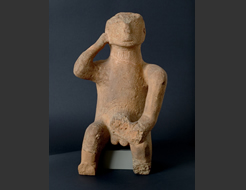|
||||||||||||||||||||||||||||||||
|
|
Museum of: Athens | |||||||||||||||||||||||||||||||
| Name of the artefact: The thinker | ||||||||||||||||||||||||||||||||
|
Large clay concrete ithyphallic figurine of a seated
male, unique due to its size, found in Thessaly at the beginning of the
20th cent. |
||||||||||||||||||||||||||||||||
|
WHERE IS IT AND MAIN
CHARACTERISTICS |
STATE |
|||||||||||||||||||||||||||||||
|
Department: |
Prehistoric |
Preservation: |
Very good | |||||||||||||||||||||||||||||
|
Inventory number: |
5894 |
Restauration: |
No restored | |||||||||||||||||||||||||||||
|
Name of the artefact: |
The thinker |
Completeness: |
Almost Complete | |||||||||||||||||||||||||||||
|
Object type: |
Human figurine |
|||||||||||||||||||||||||||||||
|
Material: |
Clay |
|||||||||||||||||||||||||||||||
|
Methof of manufacture: |
Hand made |
|||||||||||||||||||||||||||||||
|
Decoration
type: |
Incision |
|||||||||||||||||||||||||||||||
|
Distinctive mark: |
Large size |
|||||||||||||||||||||||||||||||
|
DIMENSIONS |
PERIOD OF USE |
|||||||||||||||||||||||||||||||
|
Length (mm): |
- |
Epoque: |
Neolithic |
|||||||||||||||||||||||||||||
|
Heigth
(mm): |
475 |
Culture: |
- |
|||||||||||||||||||||||||||||
|
Diameter
(mm): |
- |
Period: |
Final Neolithic |
|||||||||||||||||||||||||||||
|
Width (mm): |
195 |
Face: |
- |
|||||||||||||||||||||||||||||
|
Thickness (mm): |
- |
Absolute chronology: |
4500-3300BC |
|||||||||||||||||||||||||||||
|
Weight
(g): |
- |
|||||||||||||||||||||||||||||||
DISCOVERY |
||||||||||||||||||||||||||||||||
|
Date: |
1900 |
Country: |
Greece |
|||||||||||||||||||||||||||||
|
District: |
Thessaly |
Town hall affiliation: |
Karditsa |
|||||||||||||||||||||||||||||
|
Village: |
- |
Discovery findspot: |
- |
|||||||||||||||||||||||||||||
|
Condition of discovery: |
Chance Discovery |
Discovery type: |
Other |
|||||||||||||||||||||||||||||
|
ANALYSES – DETERMINATIONS |
FILLED IN BY |
|||||||||||||||||||||||||||||||
|
Type: |
- |
Name: |
Alexandra Christopoulou |
|||||||||||||||||||||||||||||
|
Laboratory: |
- |
Institution: |
National Archaeological Museum -
Greece |
|||||||||||||||||||||||||||||
|
No./Code: |
- |
Date: |
21/11/2005 |
|||||||||||||||||||||||||||||
|
DEEPENINGS |
||||||||||||||||||||||||||||||||
|
Morphology of the object: |
||||||||||||||||||||||||||||||||
|
Large clay concrete figure of a seated male. Final
Neolithic Period (4500-3300 BC). It is a finding of the beginning of the
20th cent,; the area of Karditsa was given as its province, when it was
brought to the National Archaeological Museum. Height 0,475m. Width on the
shoulders 0,195m. It is unique, the largest-up to the present – piece of
art of the neolithic age, since its size brings it close to the sculpture
rather than small sized prastic art. The face is angular in shape; its
mouth and nose are plastically rendered, while eyes and ears are small
holes. The grooves and incisions on the neck and the genital area rended
the male’s hair. Also important for the knowledge of anatomy is the deep
groove along the back rendering the spine. The head of the male is
tri-dimentional when compared to the plank-like flat stiff and moveless
body. The hands, assymetrical one another, are very clumsly bent, the left
on the thigh and the right by his chick. His short bent legs look more
like legs of a stool. |
||||||||||||||||||||||||||||||||
|
Decoration: |
||||||||||||||||||||||||||||||||
|
The presence of the incisions and the grooves on the
figure is connected with the appearance and the characteristics of the
male genter (hair and beard). The deep groove along its back indicate an
anatomical detail, the spine. All these can not be considered as
decorative and therefore the figure bears no decoration. |
||||||||||||||||||||||||||||||||
|
Inscription: |
||||||||||||||||||||||||||||||||
|
- |
||||||||||||||||||||||||||||||||
|
Analogies: |
||||||||||||||||||||||||||||||||
|
This male figure is unique due to its size. In general,
male figurines, compared to the female ones, are few through out the
neolithic era. When presented they are mostly rendered standed or seated
on stools with the hands on the thighs (photos 5945, 5947). They have long
hair and the genital is well formed. In some cases the figure of man was
represented by man’s distinctive trait, the phallos, sometimes as part of
everyday’s objects, like the handles of scoops (photos nos. 01, 12493 and
15948: Clay phalloid handles of everyday’s utensils, Sesklo, Late
Neolithic period 5300-4800 BC), or as pendants like no 16673 (photo - gold
amulet of hammered sheet in the shape of a phallos. Final Neolithic period
4500-3300 BC, the provenance is unknown }. |
||||||||||||||||||||||||||||||||
|
Interpretation: |
||||||||||||||||||||||||||||||||
|
The large size, the posture, the seated position of
this clay statue and, above all, the over-sized phallos point to a
specific personification. Made as to be visible from all sides, it is not
extreme to suggest, that it was placed, not in a private house, but in a
central place for the community. It may as well have represented an
agrarian deity associated with the fertility of the earth. |
||||||||||||||||||||||||||||||||
|
Bibliography: |
||||||||||||||||||||||||||||||||
|
- |
||||||||||||||||||||||||||||||||

